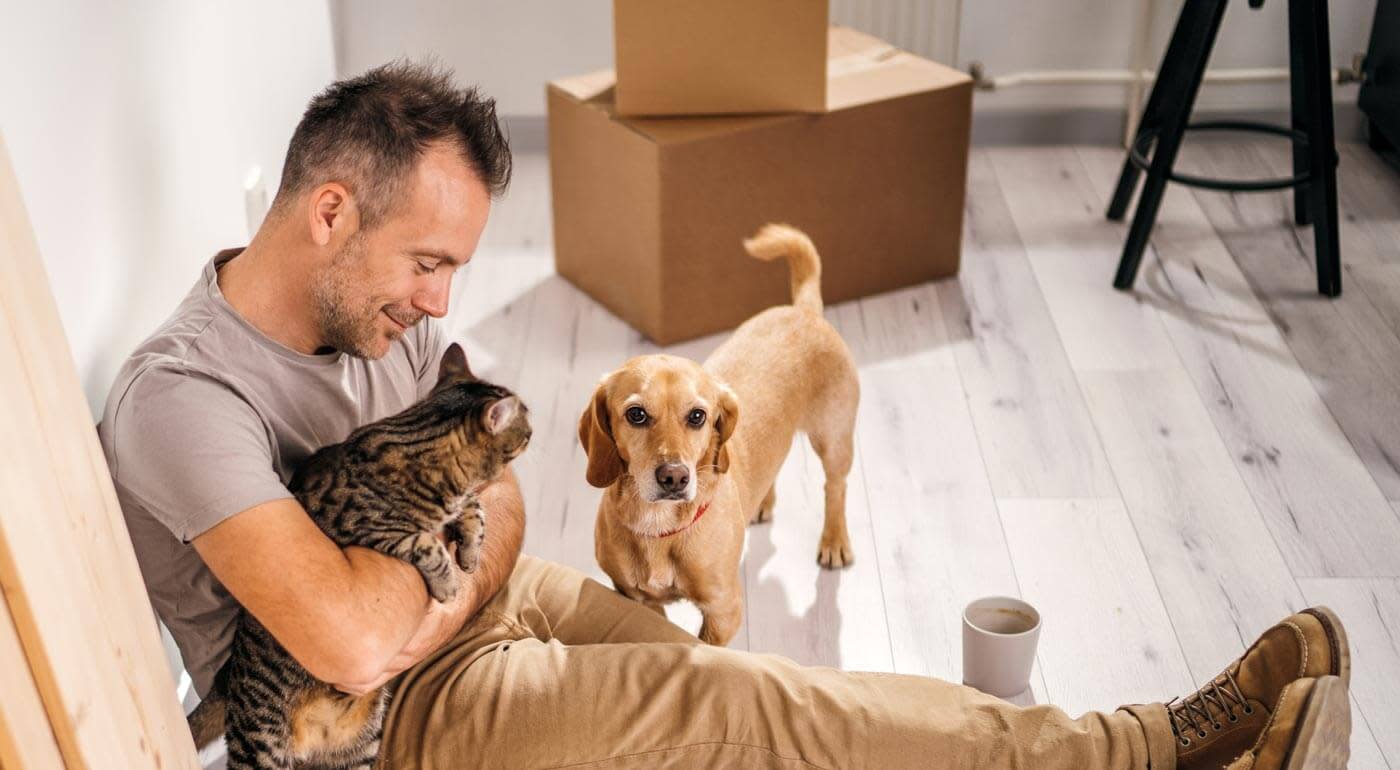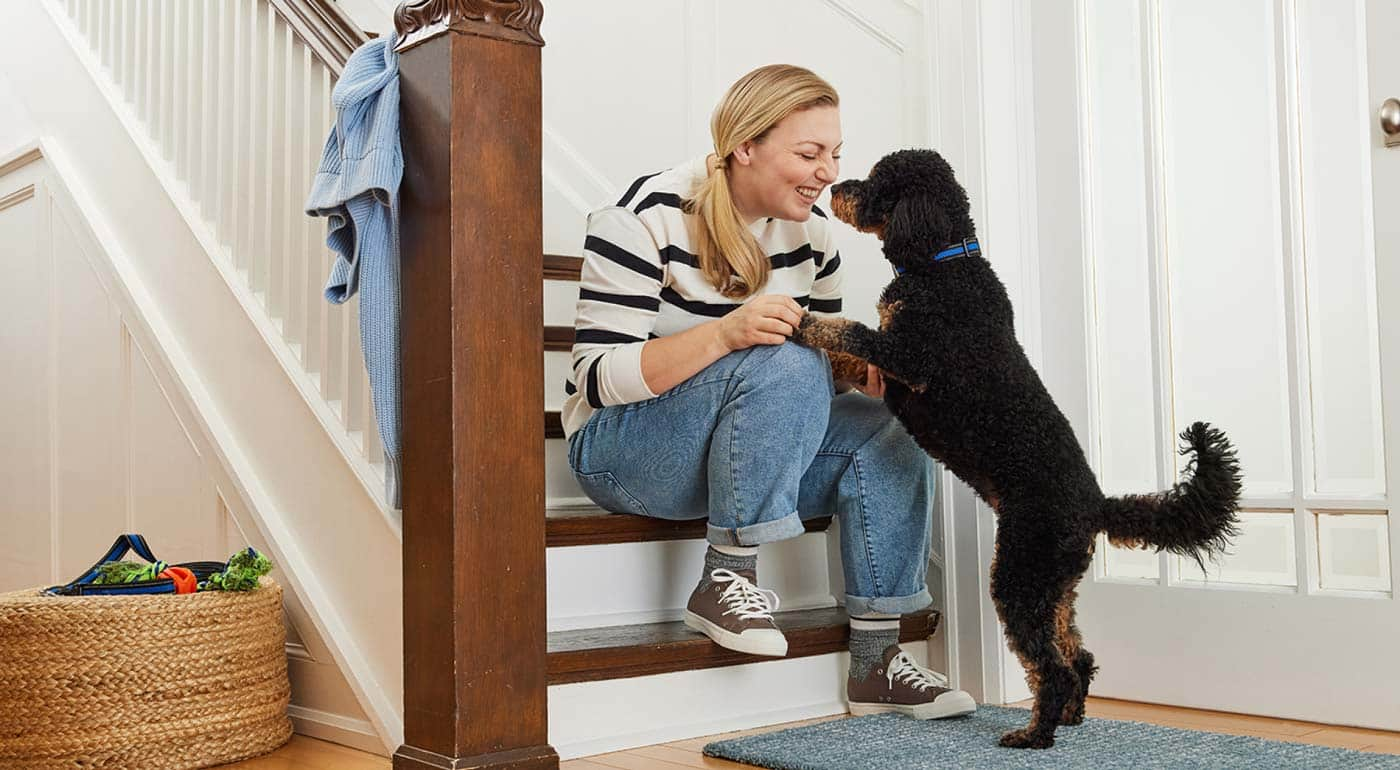Your complete guide to moving with pets

Dogs, cats, guinea pigs, lizards, and every other pet in between: they’re the most precious cargo when it comes to a move. How do you get them safely and happily from your old home to your new one? It requires planning, preparation, and a focus on what’s most important — your pet’s comfort and security. To prepare and keep anxiety levels low we’ve consulted some pet experts to figure out how to make the entire process of moving a smooth and low stress event for you and your BFF. Here’s the important advice they had to share:

Packing and planning for a move
Our pets are smart. They know when they see piles of boxes being packed and stacked in strange areas of their home that something is happening. “Pets understand that when the luggage comes out, either mom and dad, or both, are going someplace,” says Rob Keating, who owns a Pet Valu store with his partner Julie Vaillancourt. It’s the same with boxes and packing tape. When Rob and Julie moved, with their senior Schnauzer Winston in tow, he immediately recognized that those big boxes meant big change. And packing tape was not his friend. “That loud tape noise was like a lightning bolt going off behind his ears,” says Rob. He found that crate training gave Winston a place to retreat to. “Dogs are den animals like foxes and coyotes, so the crate is their safe space. That's why they enjoy them, that's why crates are so popular. If your dog can be trained to go into their crate or hang out in their crate,” he explains, “that's a good thing.” The couple also emphasizes how crucial it is to maintain your pet’s routine as much as you possibly can, which is important when you are moving with a dog. Keep to their usual feeding, walking, playing, and just-hanging-out-together schedule during the move. Pack boxes when they take their naps or are engaged with a stimulating treat or toy. Comfort them and use positive reinforcement as much as possible so they feel reassured throughout the moving process. Rob and Julie recommend making a vet visit part of your moving plan too. Ensuring that all vaccinations are up to date and that any required medications are on hand — enough to get you and your pets comfortably past your moving date — will save you from scrambling to complete those tasks post-move. If you’re switching vets following your move, do your research well ahead of time. “Especially now, after the pandemic, in some regions, it's really hard to find a vet that will take new patients,” says Julie. “So definitely secure a vet before the move and make sure that your records will be transferred.” Ask your current vet if they have any contacts or recommendations in your new area.
Preparing and showing your home
If you are selling your home as part of the move process, you’ll have to prepare to show it to potential buyers. This can create some friction for pets who are protective or territorial. Even for friendly, social animals, crowds of strangers coming into their space can still be stressful. We spoke to our friends at RE/MAX to get their insight — from a real estate perspective — on how to sell a home where pets live.
Staging a home with pets
First impressions are everything, and the objective of staging is to make the home as widely appealing as possible. This means being sensitive to prospective buyers with pet allergies or aversions. Some sellers may choose to board their pets, to keep their home in pristine condition, but this isn't the only option. Deep-cleaning the home and designating some pet zones can help keep the home ready for showings. In particular, shampooing all rugs and carpets in your home is also recommended — in case prospective buyers have pet allergies. Have a plan and a place to stash away pet toys, scratching posts and food dishes. Wipe down the walls, sweep and vacuum regularly to reduce loose fur and pet odours. If it's within your budget, you may even want to invest in a professional cleaning service. An extra pair of eyes may help detect stains and scents that might otherwise be overlooked.
Showing your home
We love our furry family members of course, but not all people are "pet people." If possible schedule showing appointments when your pet is on an outing, to ensure everyone has a pleasant experience. Consider boarding them for a short time, leaving them with friends, scheduling a day at the pet spa, or taking them on a long walk. Small animal (such as a rabbit, hamster or reptile) and bird cages should be covered. And if you have a rare or exotic pet — such as a snake, spider or rodent — perhaps consider keeping them out-of-sight during showings or temporarily placing them in a low-traffic area of the home, so as not to scare off potential buyers.

Moving day musts
The safety and comfort of our pets is a top priority on this exciting, but hectic and stressful day.
If at all possible, find a familiar friend, family member, or regular pet sitter to care for your pet during the move (preferably somewhere other than in your home). If that isn’t possible, then a securely closed crate or habitat is the safest place for a pet to be.
“What we did,” says Julie, “is to find someone (in our case our son) to take our dog for a week. So the dog was not around for the packing or the moving day. Once the dog was with us,” she adds, “we had calming pills for him since he was a bit beside himself. And we also tried to keep up with his routine, since he’s very much a routine guy.”
Routine is important for both dogs and cats.
So that you can quickly re-establish it in your new home, be sure to pack all of your pet’s needed items separately and take them with you when you go rather than trusting them to the moving company.
This will avoid the need to rifle through multiple boxes when it’s mealtime in search of kibble and dishes.
When it comes time to transport your pet between the old home and the new one, the right gear will support you in keeping your pet secure.
Crates and carriers are a good choice for cats and small dogs. Seat belts and harnesses will keep bigger dogs safely in their seats. For small pets, temperature control is important. Make sure they don’t get too cold and that their habitats are situated securely inside your vehicle.
And if your move requires travelling a long-distance, your pet will need access to food and water. For pets unaccustomed to car rides, doing short practice drives before you make the big trip will help your bestie get used to (and maybe even like) the experience.

Pet-proofing at your new place
Introducing pets to their new home should be a slow and steady process. Some aspects can be tackled beforehand, like finding and saving information about emergency 24-hour vet clinics, the location of the best off-leash dog parks, or your closest Pet Valu store. If your new home has a yard, inspect the fencing for holes, gaps, and possible pet escape routes. Do an inventory of your property’s landscaping to check for plants and vegetation that may not be pet-friendly. When you bring your dog or cat into your new home, let them explore room by room. Begin with the place where they can find their bed, food, toys, and (for cats) litter. Take dogs through the house on leash so they aren’t overwhelmed and remain in sight. Start cats out in one quiet room with their belongings so that they can adapt surrounded by items that smell familiar and of their former home.

Getting settled together
Making your new home as familiar as possible to your pet will help them settle into a new space smoothly. Avoid purchasing new bedding, dishes, or toys until after your pet is comfortable in their new environment. Similarly, don’t wash their old items ahead of the move so that they can retain their familiar, comforting scents. Place these items where your pet has easy access to them whenever they want. “Positive reinforcement is definitely part of the whole process,” says Julie. “If you do a lot of positive reinforcement with treats, your dog or cat can learn that this is okay, this is the new home, and it's not so bad.” It’s not only a new home that your pet has to get used to, but a new neighbourhood with new sights, sounds, and smells, too. These things can make a big impact (even on indoor pets) especially if you’re moving from an urban to rural area or vice versa. With Winston, Rob says that he and Julie “spent a lot of time walking the neighbourhood to get him accustomed to the new sights and sounds of the place.” Exploring your new neighbourhood together will help you understand how your pet feels about certain routes and areas, and traversing them at different times of day. Rob advises pet parents to note if certain routes are busier during specific hours — and whether that makes your pet uncomfortable. “Understanding your environment is good,” he explains, and investing in a harness and a strong leash is a smart strategy for keeping you and your pet together in the event that something in this unfamiliar environment spooks or scares them. Your new neighbourhood may also come with new laws and regulations that affect you and your pet. Look into leash laws and licensing requirements before you venture out to explore, and double-check to make certain that you’ve updated your pet’s microchip data and ID tag so that they reflect your new address and contact information. Our pets don’t understand that moving is something we all do together and that they’re included. They may act out amid so many big changes. Be patient with them and give them lots of time to adjust — and they’ll feel at home sooner rather than later.









































